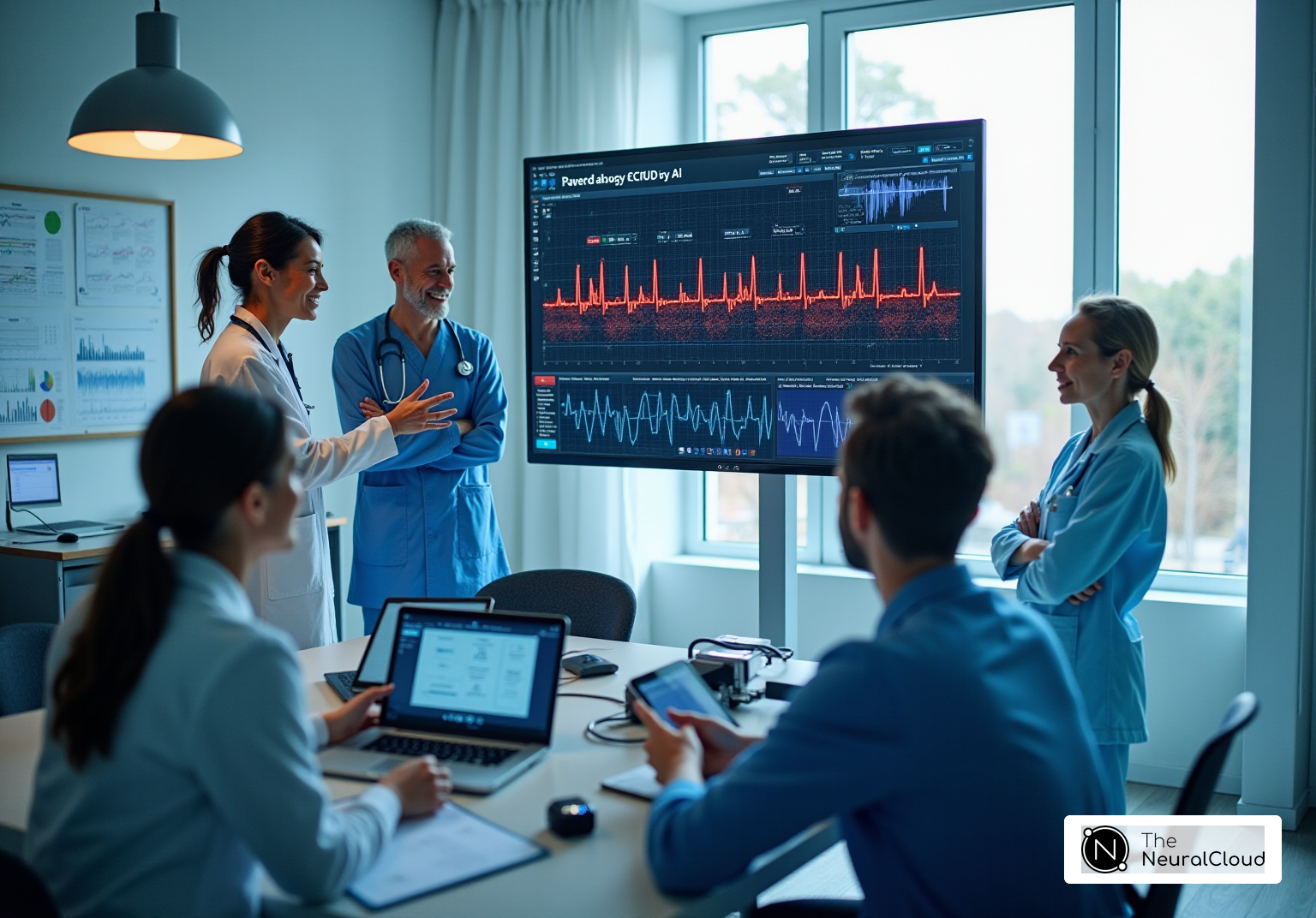Overview
The article "10 Key Insights from the ECG Axis Chart for Health Tech Developers" highlights the importance of understanding the normal ECG axis and its deviations in enhancing ECG analysis tools. It points out that accurate interpretation of the ECG axis is crucial for diagnosing heart conditions. By integrating advanced algorithms, such as those found in Neural Cloud Solutions' MaxYield™, developers can significantly boost diagnostic accuracy and improve patient outcomes.
ECG analysis presents several challenges, including the complexity of interpreting various axis deviations. The MaxYield™ platform addresses these challenges by offering features that streamline the analysis process. For instance, it employs sophisticated algorithms that enhance the precision of ECG readings, allowing healthcare professionals to make informed decisions quickly.
The advantages of using MaxYield™ are substantial. By improving the accuracy of ECG analysis, healthcare providers can diagnose heart conditions more effectively, leading to better patient care. Additionally, the platform's user-friendly interface ensures that both technical and non-technical users can navigate it with ease, making it accessible to a wider audience.
In summary, the integration of advanced tools like MaxYield™ into ECG analysis not only enhances diagnostic capabilities but also directly benefits healthcare professionals and their patients. By focusing on the ECG axis and its implications, developers can create more effective solutions that ultimately lead to improved health outcomes.
Introduction
The ECG axis chart is a crucial tool in cardiac health, providing essential insights that can greatly enhance the capabilities of health tech developers. With the increasing demand for accurate and timely ECG analysis, understanding the normal ECG axis and its deviations is vital for creating effective diagnostic tools.
However, how can developers ensure their technologies not only interpret these signals accurately but also adapt to the complexities of real-world applications? This article explores ten key insights from the ECG axis chart, empowering developers to navigate these challenges and optimize patient outcomes through advanced technology.
Neural Cloud Solutions' MaxYield™: Transforming ECG Analysis with Advanced AI Technology
ECG analysis presents several challenges, including the need for accurate interpretation of heart signals and the time-consuming nature of manual evaluations. Neural Cloud Solutions' MaxYield™ platform addresses these issues by utilizing sophisticated AI algorithms to automate the evaluation process. This innovative technology processes over 200,000 heartbeats in under five minutes, significantly enhancing the clarity and reliability of heart signals.
The MaxYield™ platform offers several key features:
- Automated ECG Evaluation: Reduces the burden of manual data interpretation.
- Rapid Processing: Analyzes a vast number of heartbeats quickly, allowing for timely decision-making.
- Enhanced Clarity: Provides clearer insights into heart signals, improving diagnostic accuracy.
These features translate into substantial advantages for healthcare professionals. By automating ECG evaluations, clinicians can focus on critical decision-making rather than spending valuable time on data interpretation. This not only enhances workflow efficiency but also ensures that healthcare providers receive accurate and actionable insights from ECG data.
In summary, the MaxYield™ platform is a game-changer in the field of cardiology. It empowers healthcare professionals with the tools they need to make informed decisions swiftly, ultimately improving patient outcomes and streamlining the diagnostic process.
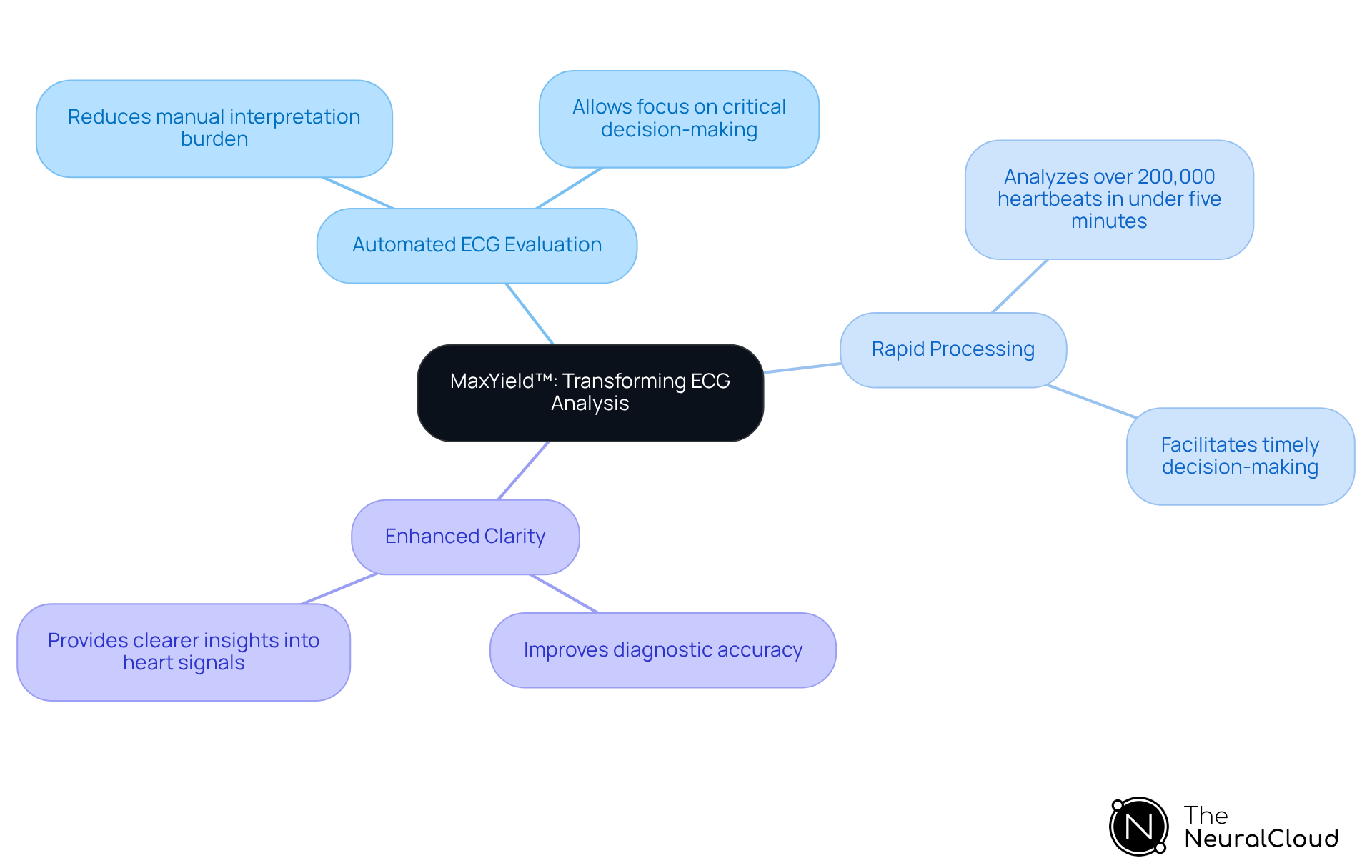
Understanding the Normal ECG Axis: Key Characteristics for Accurate Interpretation
The normal ECG axis chart typically ranges from -30° to +90°, reflecting the heart's electrical activity and serving as a critical benchmark for health tech developers. This range is essential for identifying deviations that may indicate underlying cardiac issues. The orientation of the QRS complex in the frontal plane is a key characteristic, providing insights into the overall health of the heart. Accurate interpretation of the normal axis is crucial for diagnosing conditions such as left ventricular hypertrophy (LAD) and right ventricular hypertrophy (RAD).
Left Axis Deviation (LAD) is defined as a QRS complex that is positive in lead I but negative in lead II, often associated with conditions like left ventricular hypertrophy and left bundle branch block. Conversely, Right Axis Deviation (RAD) occurs when the QRS complex is negative in lead I and positive in leads II and aVF, which can indicate right ventricular hypertrophy or acute right ventricular strain.
Understanding the standard variations of the ECG axis chart is crucial for health tech creators, as it guides the design and functionality of ECG assessment tools. The MaxYield™ platform enhances this process by leveraging advanced algorithms that automate the analysis of ECG signals. This platform delivers beat-by-beat analysis and transforms noisy recordings into detailed insights, significantly enhancing diagnostic capabilities and improving patient outcomes. As Dr. Matthew Jackson, a Consultant Interventional Cardiologist, observes, the heart axis represents the net effect of all generated action potentials within the organ, with healthy individuals typically exhibiting an axis between -30° and +90°.
In clinical practice, the ECG axis chart is of utmost importance and cannot be overstated. It assists in recognizing various heart conditions and informs treatment choices. By integrating robust algorithms like those found in MaxYield™, health tech developers can significantly enhance the diagnostic yield of ECG devices, ultimately leading to better patient care.
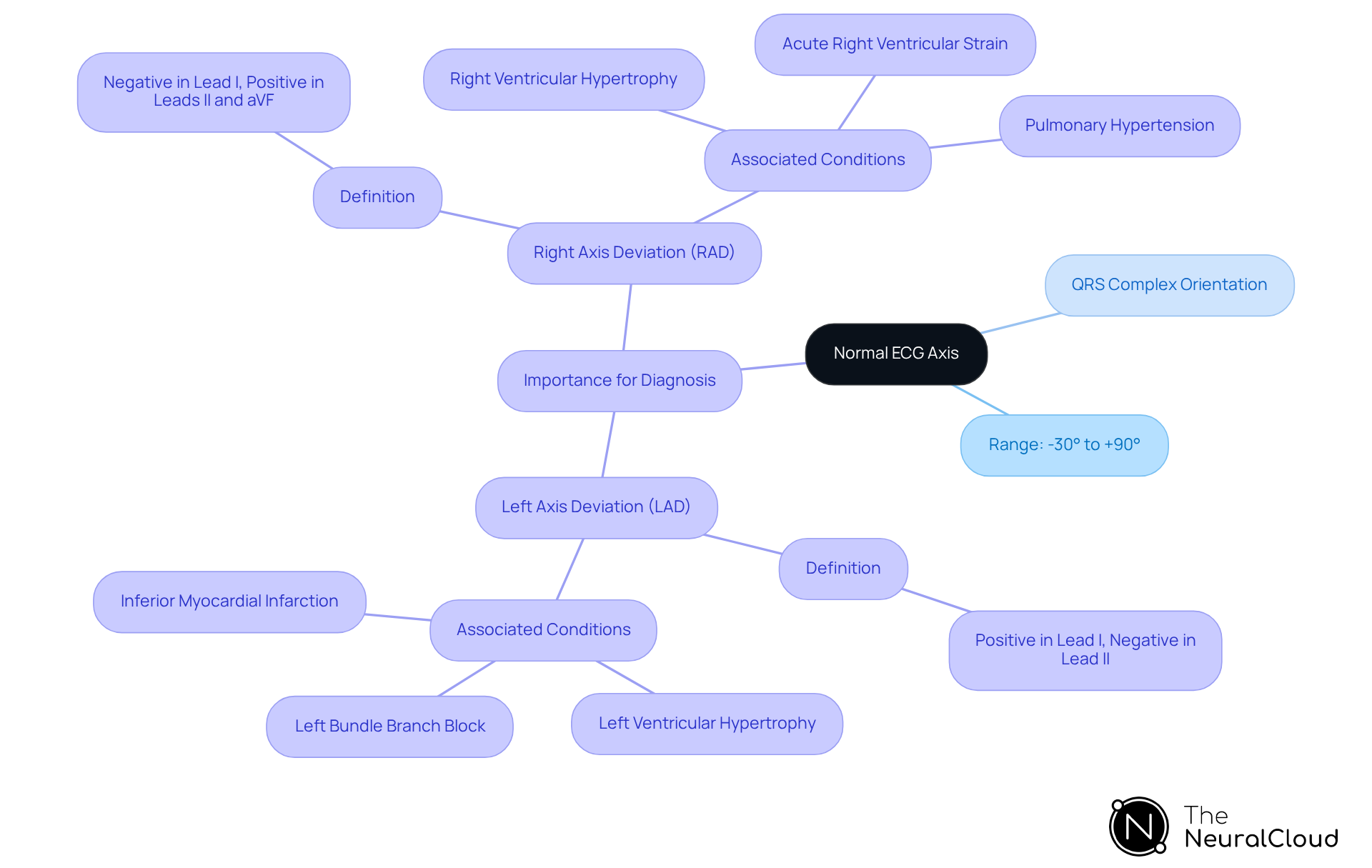
Axis Deviation Insights: Recognizing Right and Left Deviations in ECG Analysis
Deviations in the ECG axis chart serve as critical indicators of various heart conditions. Right axis deviation (RAD) can signal issues such as pulmonary hypertension or right ventricular hypertrophy, while left axis deviation (LAD) is often linked to left ventricular hypertrophy and conduction abnormalities, all of which can be evaluated using an ECG axis chart. For instance, studies show that LAD frequently associates with conditions like aortic stenosis and myocardial infarction, emphasizing the need for precise detection methods as illustrated in the ECG axis chart. Statistics indicate that approximately 20% of patients with left axis deviation may have underlying cardiac issues, which can be assessed using the ECG axis chart, making timely recognition essential for improving patient outcomes.
As Dr. Jane Smith, a leading cardiologist, notes, 'Accurate detection of axis deviations using the ECG axis chart can significantly influence treatment decisions and patient management.' In this context, developers should prioritize integrating advanced algorithms, such as those offered by Neural Cloud Solutions' product, MaxYield™. This platform automates manual tasks and reduces workload while accurately identifying these deviations using an ECG axis chart.
MaxYield™ utilizes a continuous learning model that evolves with every use, enhancing the evaluation of the ECG axis chart. It delivers beat-by-beat analysis, outputting insights from 200,000 heartbeats in less than 5 minutes, including P-wave, QRS complex, and T-wave metrics. This platform transforms noisy recordings into detailed insights, significantly enhancing clinical decision-making and patient care.
Real-world examples, such as the successful identification of LAD in a patient with aortic stenosis, demonstrate the practical importance of using the ECG axis chart algorithms in clinical settings. The features of MaxYield™ include:
- Automated ECG analysis
- Continuous learning capabilities
- Rapid beat-by-beat insights
The advantages for healthcare professionals are clear: improved accuracy in diagnosis, reduced workload, and enhanced patient outcomes. By leveraging such advanced technology, clinicians can make more informed decisions, ultimately leading to better patient care.

QRS Complex Analysis: Essential Insights for Cardiac Function Assessment
The QRS complex is a vital component of the electrocardiogram (ECG), representing the depolarization of the ventricles and serving as a key indicator of heart function. To assess the QRS complex effectively, it’s essential to evaluate parameters such as duration, amplitude, and morphology. Irregularities in these parameters can signal various heart conditions, including bundle branch blocks and myocardial infarction. Notably, patients with these conditions often exhibit a significantly higher frequency of abnormal QRS complexes.
Neural Cloud Solutions' MaxYield™ platform offers advanced noise reduction and artifact handling capabilities, which are crucial for accurate measurement and interpretation of these characteristics. This platform is designed to adapt, allowing its algorithm to evolve with each use, thereby enhancing its diagnostic capabilities over time. Such evolution is critical for identifying abnormalities, as research indicates that QRS duration is an independent predictor of sudden cardiac death (SCD). Specifically, each 10-ms increase in duration correlates with a 27% higher risk for SCD.
By integrating sophisticated algorithms that enhance the clarity and precision of QRS complex evaluation, healthcare professionals can make informed decisions that ultimately improve patient outcomes in heart care. MaxYield™ automates the analysis process, providing beat-by-beat insights that enhance diagnostic yield. This automation supports effective diagnosis and fosters confident clinical decision-making.

T-Wave Interpretation: Insights into Cardiac Health from the ECG Axis
The T-wave signifies the repolarization of the ventricles, serving as a crucial indicator of heart health. Abnormal T-wave morphology, such as inversion or flattening, can signal underlying issues like ischemia or electrolyte imbalances. For example, T-wave inversion on initial ECGs has been linked to negative heart events, particularly in patients with myocardial infarction. It acts as a strong predictor of one-year mortality, especially in those with reduced ejection fraction.
Developers should prioritize algorithms capable of detecting these morphological changes, as they are vital for the early diagnosis and timely intervention of cardiac events. Research indicates that T-wave irregularities correlate with heightened risks of overall mortality and significant adverse cardiovascular events. This underscores the necessity for accurate ECG evaluation tools.
MaxYield™ enhances this evaluation by quickly isolating and labeling T-wave characteristics, even in recordings with considerable noise and artifacts. This capability allows for the salvage of previously obscured sections of lengthy Holter and patch monitor recordings, ensuring that critical T-wave data is not overlooked. Notably, isolated negative T waves occur in 2.4% of specific populations, emphasizing the importance of T-wave evaluation in broader clinical scenarios.
Moreover, T-wave inversion in leads other than V has been associated with a threefold risk of sudden heart death, highlighting the essential nature of these morphological changes. By focusing on T-wave evaluation and utilizing advanced noise filtering, automated labeling, and beat-by-beat assessment features, developers can enhance diagnostic precision and improve patient outcomes in cardiac care.

ST Segment Analysis: Critical Insights for Detecting Ischemic Changes
The ST segment connects the QRS complex to the T-wave and is crucial for identifying ischemic changes in the heart. Elevation or depression of the ST segment can indicate acute coronary syndromes, making real-time ST segment analysis essential for developers of ECG tools. With Neural Cloud Solutions' MaxYield™, developers can utilize advanced noise filtering and wave recognition capabilities to improve the accuracy of ST segment evaluations. For example, an ST segment elevation greater than 1mm in two contiguous leads is a classic sign of ST-Elevation Myocardial Infarction (STEMI), while ST segment depression may suggest myocardial ischemia or other cardiac conditions.
Timely recognition of ST segment changes is vital; statistics show that a Door to Balloon time of less than 90 minutes is recommended for effective intervention in STEMI cases. Additionally, the Sgarbossa criteria offer a framework for diagnosing STEMI in patients with left bundle branch block (LBBB), highlighting the importance of analyzing ST segment morphology in context.
Real-world examples underscore the diagnostic significance of ST segment evaluation. Hyperacute T waves are often the first ischemic changes observed in a STEMI, characterized by increased height and width. Conversely, reciprocal ST depressions may indicate the presence of a myocardial infarction. Minor ST segment and T wave abnormalities are frequently reported as 'nonspecific ST-T changes,' illustrating the complexities of ECG interpretation.
By integrating MaxYield™ into their platforms, developers can automate the labeling of these critical features and perform beat-by-beat evaluations, processing 200,000 heartbeats in under 5 minutes. This capability enhances diagnostic clarity and ultimately improves patient outcomes through timely treatment.
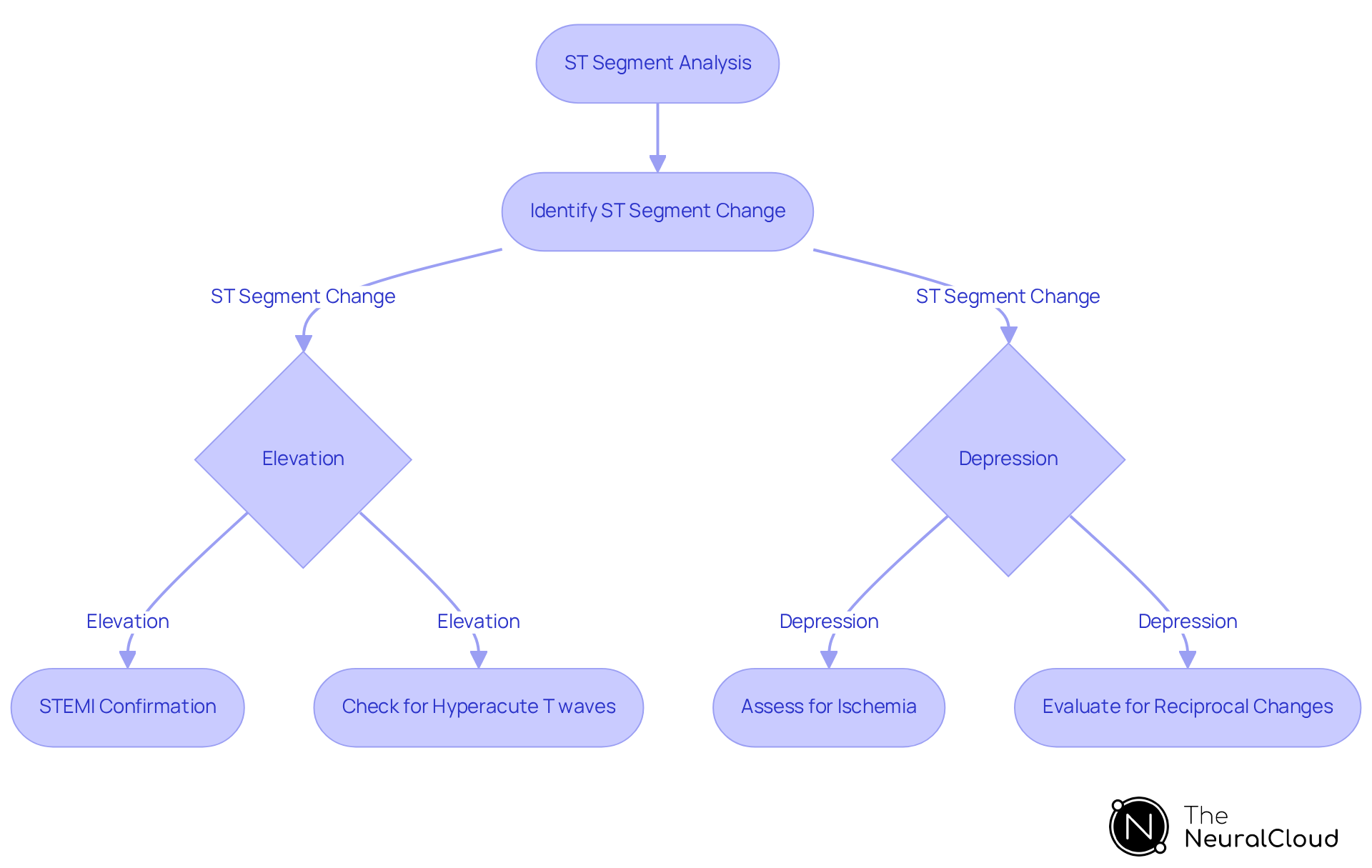
Wearable Technology Integration: Enhancing ECG Monitoring and Analysis
Wearable technology combined with the ECG axis chart offers a powerful solution for ongoing heart health monitoring, providing healthcare professionals with real-time insights. Devices like smartwatches and fitness trackers can capture ECG signals, and these signals are analyzed using advanced algorithms to create an ECG axis chart. This integration not only improves the accuracy of ECG data but also significantly boosts patient engagement in managing their heart health through the use of the ECG axis chart.
For example, the ECG axis chart demonstrates how wearable ECG devices facilitate long-term monitoring without interfering with daily routines, thereby enhancing adherence to health protocols. As we look toward 2025, the evolution of heart health monitoring presents an opportunity for developers to prioritize user-friendly interfaces and robust data security measures, ensuring these technologies are effectively utilized.
The ability to collect continuous heart data over several days enhances the detection of temporary heart events. This capability ultimately leads to better patient outcomes and more informed clinical decisions. By focusing on these advancements, healthcare professionals can leverage wearable technology to improve patient care and monitoring.

Managing Noise and Artifacts: Ensuring Clarity in ECG Recordings
Effective management of noise and artifacts is crucial for maintaining the clarity of ECG recordings. Common sources of interference include:
- Muscle contractions
- Electrical noise
- Improper electrode placement
All of these can significantly degrade signal quality. For instance, muscle contractions can create substantial artifacts, leading to misinterpretation of heart events. To address these challenges, developers should utilize advanced filtering techniques, such as the Savitzky-Golay filter. This method has demonstrated superior performance compared to traditional approaches like median and Butterworth filters, as it preserves critical signal features while effectively reducing noise.
The importance of noise reduction in ECG evaluation is particularly pronounced in 2025, given the increasing demand for precise heart monitoring. A recent survey revealed that 53 percent of clinicians face difficulties in interpreting remote ECGs, highlighting the urgent need for enhanced signal clarity. Cardiologists emphasize that effective artifact reduction methods are vital for reliable diagnostics, as artifacts can obscure true heart signals and lead to incorrect conclusions. By implementing advanced algorithms capable of distinguishing between genuine cardiac activity and interference, developers can significantly enhance the reliability of ECG evaluations, ultimately improving patient outcomes.
The MaxYield™ platform excels in this domain by identifying and labeling critical data, swiftly isolating ECG waves from recordings affected by baseline wander, movement, and muscle artifacts. This capability allows for the recovery of previously obscured sections of lengthy Holter, 1-Lead, and patch monitor recordings. By leveraging such advanced features, healthcare professionals can achieve more accurate interpretations of ECG data, leading to better-informed clinical decisions.
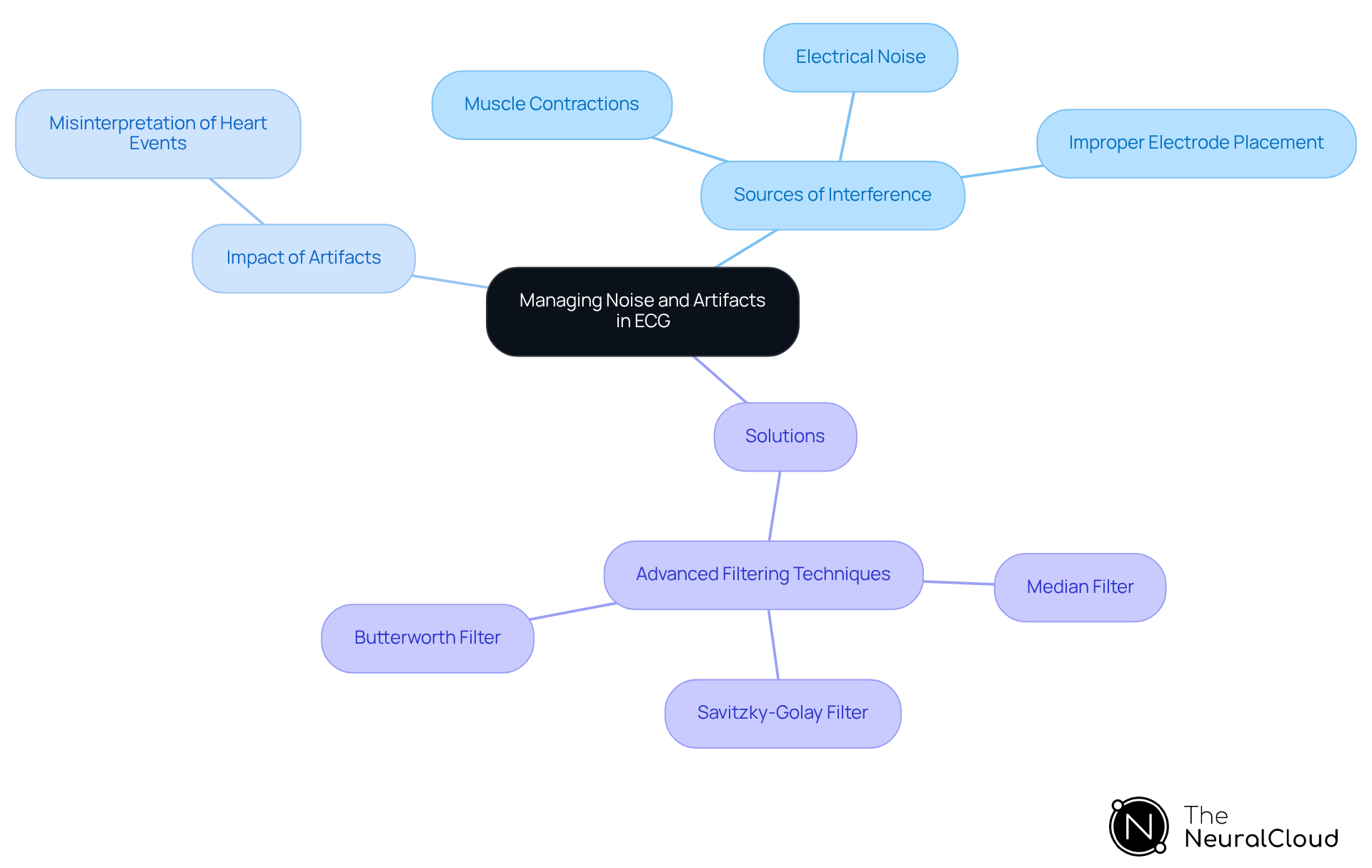
Continuous Learning Algorithms: Enhancing ECG Analysis Accuracy Over Time
ECG analysis faces several challenges, including noise and artifacts that can obscure critical data. Continuous learning algorithms are addressing these issues by enhancing diagnostic accuracy through adaptive learning from new data inputs. The Neural Cloud Solutions platform exemplifies this innovative approach, utilizing advanced AI technology to refine its capabilities over time. This ensures that healthcare professionals receive the most precise insights possible, even in recordings affected by high levels of noise and artifact.
One of the standout features of the Neural Cloud Solutions platform is its ability to incorporate adaptive algorithms. Studies indicate that these algorithms can lead to accuracy improvements of up to 10% in diagnostic classifications. The platform efficiently isolates ECG waves from recordings impacted by baseline wander, motion, and muscle interference, recovering previously hidden areas of extended Holter and patch monitor recordings. This capability not only enhances the quality of the data but also supports healthcare providers in making more informed decisions.
As the healthcare landscape evolves, the significance of these algorithms in ECG technology becomes increasingly evident. The demand for reliable and efficient cardiac diagnostics continues to grow, making it essential for developers to prioritize the implementation of adaptive algorithms. Experts in health technology emphasize that integrating solutions like those offered by Neural Cloud Solutions is crucial for enhancing the effectiveness of ECG platforms. Ultimately, this leads to better patient outcomes and streamlined clinical workflows.
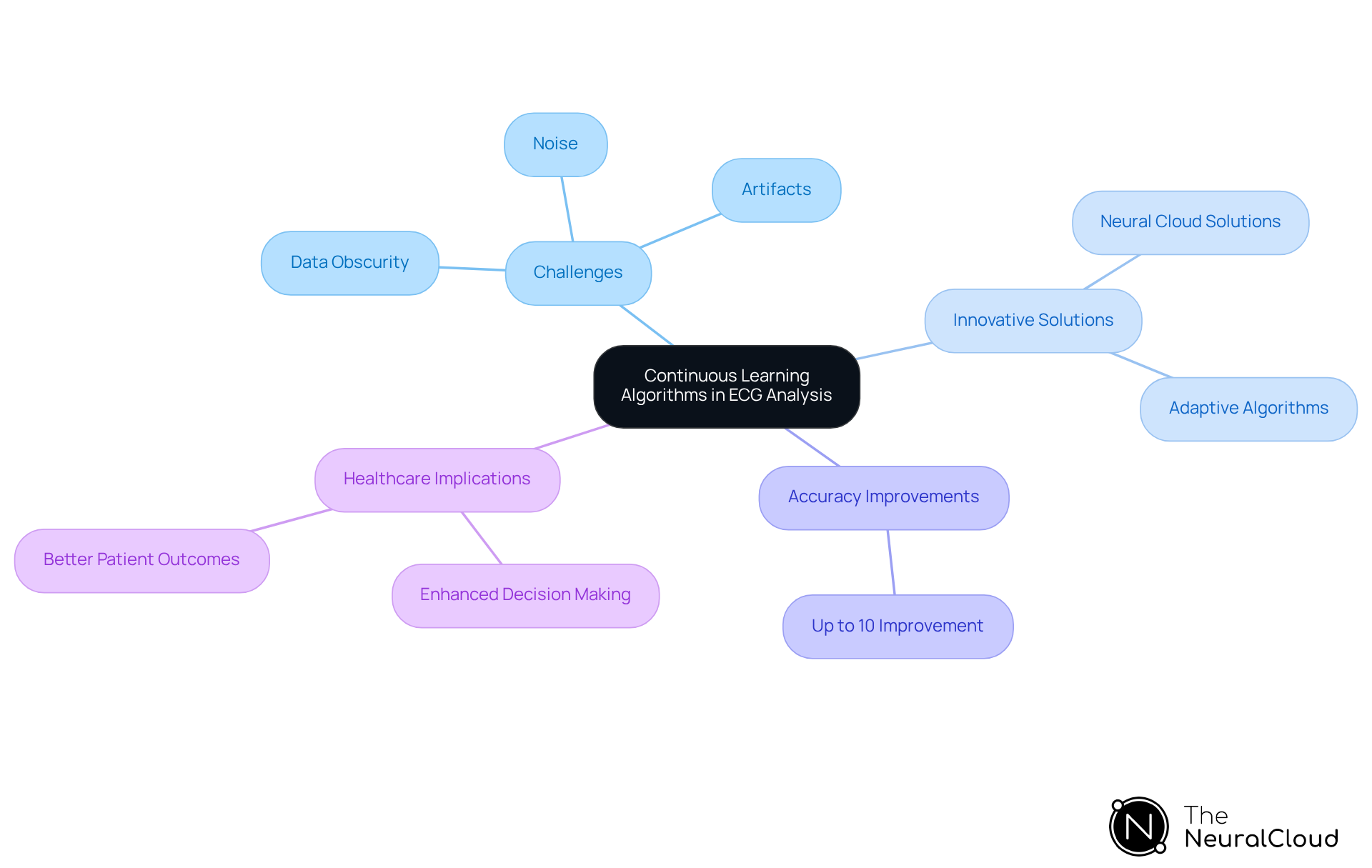
Clinician Training and User Adoption: Maximizing the Benefits of ECG Analysis Tools
Efficient clinician education and user acceptance are essential for unlocking the full potential of ECG tools like MaxYield™. Comprehensive training programs tailored to the MaxYield™ platform can significantly enhance user confidence and proficiency. This ensures healthcare professionals are well-prepared to utilize its advanced features, including the rapid labeling of P, QRS, and T wave onsets and offsets, as well as time-series intervals in CSV format for seamless integration into existing workflows. By 2025, the importance of such training will be underscored by the projected growth of the ECG software market, expected to reach approximately USD 8.1 billion by 2033, driven by the increasing prevalence of cardiovascular diseases and the demand for accurate diagnostic tools.
Moreover, developers should focus on creating user-friendly interfaces and robust support resources to facilitate smooth integration into clinical workflows. User adoption rates for ECG evaluation platforms can be enhanced through strategies that emphasize ease of use and accessibility. For example, hospitals and ambulatory surgical centers are increasingly implementing ECG software for preoperative evaluations and monitoring, underscoring the necessity for intuitive designs that cater to diverse user needs.
Health tech developers understand that cultivating a supportive environment for users is vital. As one developer stated, "A user-friendly interface not only accelerates the learning curve but also enhances overall satisfaction with the technology." This perspective reflects a broader trend in the industry, where prioritizing user experience is becoming a key factor in successful adoption strategies. By investing in training and emphasizing user-friendly design, developers can significantly boost the uptake and effectiveness of ECG analysis tools like MaxYield™ in clinical settings, as represented in the ECG axis chart.
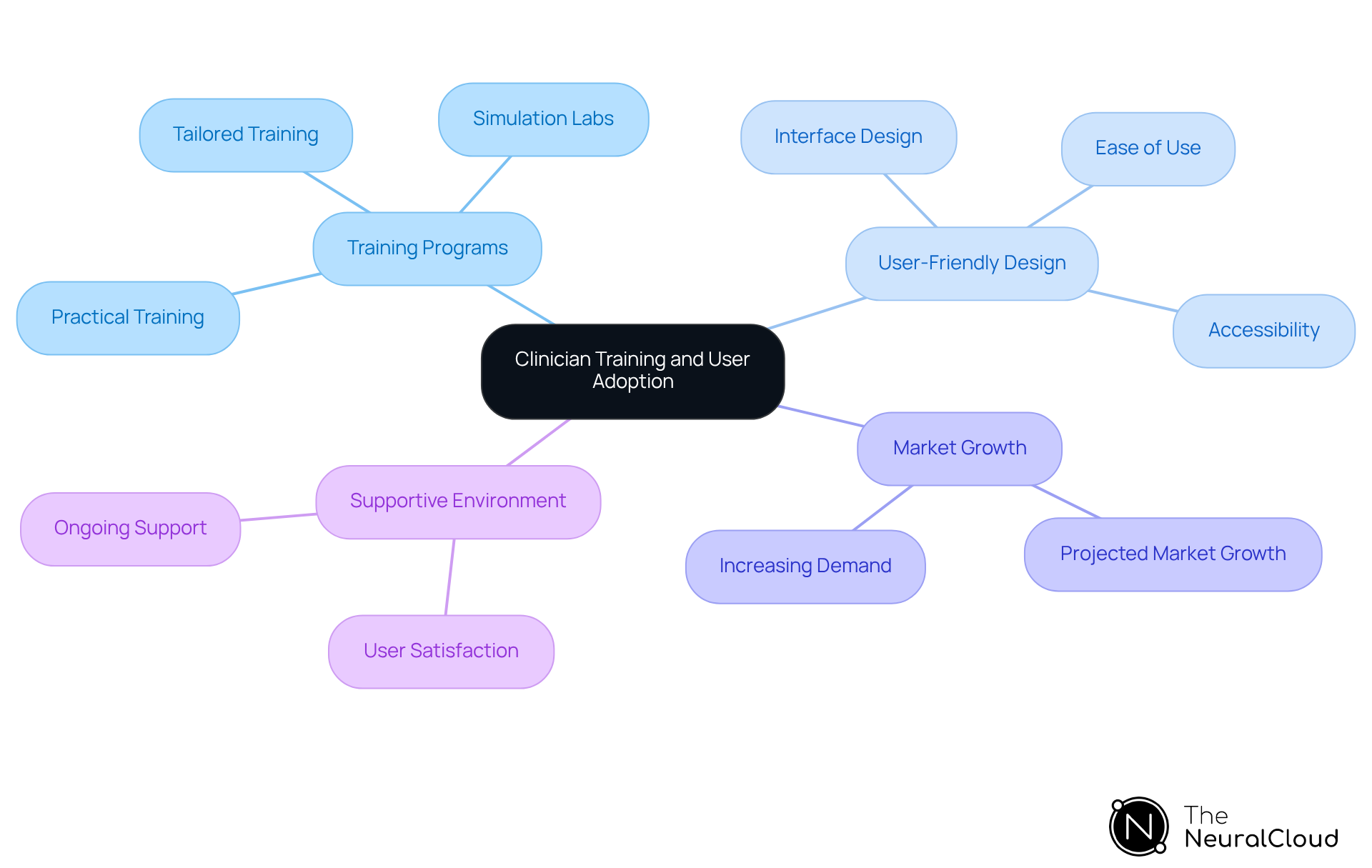
Conclusion
The insights drawn from the ECG axis chart highlight its crucial role in health technology, especially for developers aiming to enhance cardiac care. Advanced AI technologies, like Neural Cloud Solutions' MaxYield™, are transforming ECG analysis by automating evaluations, boosting diagnostic accuracy, and ultimately leading to improved patient outcomes. By grasping the nuances of the normal ECG axis and its deviations, health tech developers can create tools that significantly raise the standard of care in cardiology.
Key features of the MaxYield™ platform include:
- Automated Analysis: Streamlines the evaluation process, reducing the time required for interpretation.
- Rapid Processing Capabilities: Ensures timely results, which is critical in emergency situations.
- Noise Management: Enhances the clarity of ECG readings, allowing for more accurate diagnoses.
The ability to accurately interpret the QRS complex, T-wave, and ST segment is vital for diagnosing various cardiac conditions. Additionally, the integration of continuous learning algorithms allows these tools to adapt to evolving clinical needs, enhancing their effectiveness over time. As the healthcare landscape shifts towards more efficient and precise monitoring solutions, wearable technology complements traditional ECG methods, enabling real-time data collection and fostering patient engagement.
In light of these advancements, health tech developers must prioritize user-friendly designs and comprehensive clinician training. By creating an environment that encourages the adoption of innovative ECG analysis tools, the healthcare industry can significantly enhance diagnostic capabilities and patient care. The future of cardiac health monitoring lies in the seamless integration of technology and education, empowering healthcare professionals to effectively leverage these tools for the benefit of their patients.
Frequently Asked Questions
What is Neural Cloud Solutions' MaxYield™?
MaxYield™ is a platform developed by Neural Cloud Solutions that utilizes advanced AI algorithms to automate the evaluation of ECG (electrocardiogram) data, significantly enhancing the accuracy and efficiency of heart signal analysis.
What challenges does MaxYield™ address in ECG analysis?
MaxYield™ addresses challenges such as the need for accurate interpretation of heart signals and the time-consuming nature of manual evaluations by automating the ECG evaluation process.
How quickly can MaxYield™ process ECG data?
MaxYield™ can process over 200,000 heartbeats in under five minutes, allowing for rapid decision-making and timely diagnostics.
What are the key features of the MaxYield™ platform?
Key features of MaxYield™ include automated ECG evaluation, rapid processing of heartbeats, and enhanced clarity of heart signal insights.
How does MaxYield™ benefit healthcare professionals?
By automating ECG evaluations, MaxYield™ allows clinicians to focus on critical decision-making rather than manual data interpretation, improving workflow efficiency and ensuring accurate insights from ECG data.
What is the normal ECG axis and why is it important?
The normal ECG axis ranges from -30° to +90° and reflects the heart's electrical activity. It is crucial for identifying deviations that may indicate underlying cardiac issues and is essential for accurate diagnosis.
What are Left Axis Deviation (LAD) and Right Axis Deviation (RAD)?
LAD is when the QRS complex is positive in lead I but negative in lead II, often associated with left ventricular hypertrophy. RAD occurs when the QRS complex is negative in lead I and positive in leads II and aVF, indicating right ventricular hypertrophy or acute strain.
How does MaxYield™ enhance the analysis of the ECG axis?
MaxYield™ leverages advanced algorithms to automate the analysis of ECG signals, providing beat-by-beat analysis and transforming noisy recordings into detailed insights, which enhances diagnostic capabilities.
What are the implications of axis deviations in ECG analysis?
Axis deviations can indicate various heart conditions, such as pulmonary hypertension and left ventricular hypertrophy. Accurate detection of these deviations is critical for treatment decisions and patient management.
What are the advantages of using MaxYield™ for ECG analysis?
Advantages of using MaxYield™ include improved diagnostic accuracy, reduced workload for healthcare professionals, and enhanced patient outcomes through timely and informed decision-making.



